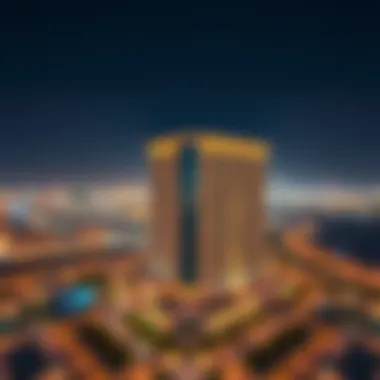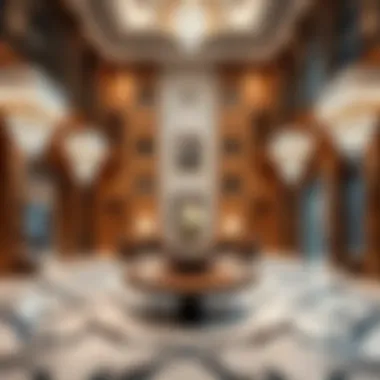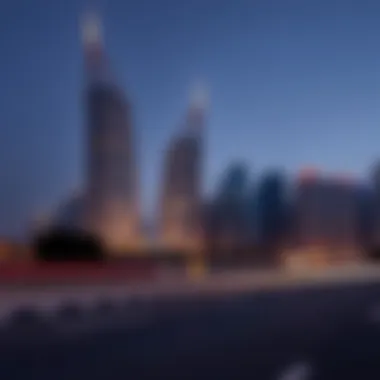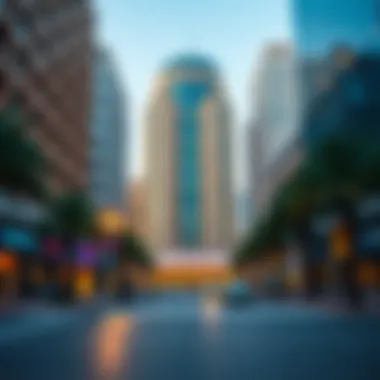Exploring the Nasser Rashid Lootah Building in Dubai


Intro
Dubai's skyline is a captivating blend of the modern and traditional, punctuated by architectural marvels that leave an indelible impression. Among these, the Nasser Rashid Lootah Building stands as a prime example of innovative design and functionality. This article unpacks the layers of this iconic structure, setting the stage to understand its impact on the city's real estate dynamics and its broader significance within Dubai's vibrant cultural tapestry.
As we dive deeper, important themes emerge, from the building's architectural details to its historical backdrop, and the role it plays in shaping modern living and investment trends in Dubai. With both breadth and depth, we aim to give the reader a nuanced view of this landmark, revealing not just its exterior elegance but also its underlying connections to the market and community.
By the end, we hope to provide valuable insights for investors, property managers, and home buyers who are keen to explore opportunities within this burgeoning metropolis.
Preamble to the Nasser Rashid Lootah Building
The Nasser Rashid Lootah Building stands tall and proud against Dubai’s ever-changing skyline. This iconic structure not only contributes to the city's architectural beauty but also represents a significant milestone in the evolution of urban living in one of the world’s fastest-growing cities. Understanding the importance of this building provides insight into the broader context of Dubai's ambitious development plans and its impact on real estate dynamics.
Overview of the Building
The Nasser Rashid Lootah Building is a prime example of modern architectural design, seamlessly blending utility and aesthetics. Designed with clean lines and a futuristic silhouette, the building features a façade that captures the harsh desert sun while providing a welcoming atmosphere for its inhabitants. The structure's height and unique design contribute to its status as a recognizable landmark in the bustling metropolis. With residential units interspersed among commercial spaces, it caters to a diverse range of tenants, making it a desirable location for both families and businesses.
The interior layout of the building is well thought out, with spacious apartments that boast panoramic views of the Dubai skyline. Amenities, including gyms, swimming pools, and children’s play areas, add to the appeal for those looking to live or work in a thriving environment. When stepping into the lobby, visitors are greeted by high ceilings and an elegant design that establishes the building’s upscale vibe.
Significance in Dubai's Architecture
In a city known for its architectural feats, the Nasser Rashid Lootah Building plays a crucial role in defining the urban landscape. Its design reflects not only contemporary aesthetics but also Dubai's cultural narratives and economic aspirations. As the city aims to be a global hub for trade, tourism, and innovation, this building symbolizes that vision through its blend of functionality and modern design.
Furthermore, the architecture of this building signals a shift towards sustainable practices in Dubai. The inclusion of energy-efficient technologies and environmentally friendly materials illustrates a commitment to sustainability, aligning with the wider global trend of green building initiatives. This aspect is not just a passing trend; it’s an essential consideration for future developments in Dubai's increasingly competitive real estate market.
"To appreciate the Nasser Rashid Lootah Building is to understand Dubai itself — a fusion of tradition and innovation, where every building contributes to a larger narrative of growth and resilience."
In summary, the introduction of the Nasser Rashid Lootah Building opens the floor to discussions about urban development in Dubai, touching on its architectural significance, economic implications, and the social fabric of the community it serves. The fabric of this building is woven with layers of meaning that extend beyond mere brick and mortar, finding resonance with varied stakeholders, from investors to potential residents.
Historical Context
The historical context of the Nasser Rashid Lootah Building is essential in understanding its place in Dubai's architectural narrative. It illustrates how the city has evolved over decades, particularly how landmark structures contribute to its identity. This section sheds light on the significant timelines and influences that have shaped the evolution of this iconic structure, offering critical insights for investors and stakeholders.
Foundation and Development
The foundation period of the Nasser Rashid Lootah Building began in the early 2000s, at a time when Dubai was vigorously embracing modernization. The city was transforming from a quaint fishing village into a bustling metropolis, a metamorphosis marked by unprecedented growth in real estate. Developers and investors recognized an opportunity to establish structures that symbolized the economic boom.
The building itself represents not just a milestone in construction, but a reflection of the ambition and determination of its developer, Nasser Rashid Lootah. As one of the pioneering figures in Dubai’s real estate sector, Lootah sought to create a residential oasis amidst the urban sprawl, catering to the needs of a growing population keen to enjoy modern amenities.
In a practical sense, the building's foundation was engineered using advanced technology. This guaranteed stability in a notoriously windy area, and cemented its role as a reliable and enduring asset in the competitive Dubai property market. The meticulous planning and development stages ensured that the structure would meet not only contemporary design standards but also future sustainability requirements.
Key Milestones in Construction
The construction of the Nasser Rashid Lootah Building marked critical milestones that resonated well beyond its physical presence. Major developments occurred in various phases, shaping the architectural landscape of Dubai in distinct ways. One such milestone was the completion of the framework in 2005; it was an ambitious undertaking that brought together international architects and local labor, fostering a blend of cultures.
A noteworthy moment came during the topping-off ceremony held in 2007, which symbolized a significant point of achievement in the building’s timeline. It wasn't merely an event for the developers, but a celebration of the collective efforts from various teams, reinforcing the collaborative spirit inherent in Dubai's construction industry.


"Each concrete block laid was not just about building walls; it was about constructing dreams and aspirations for many who wished to call this bustling city home."
Timing was crucial; the final touches were completed in 2009, coinciding with Dubai's rising prominence as a global trade hub. The completion of the building served as a statement – Dubai wasn't just keeping pace with global architectural trends but was indeed leading them.
Evolution of Surrounding Areas
The evolution of the surrounding areas of the Nasser Rashid Lootah Building has been equally remarkable. As construction progressed, the landscape began to morph into a thriving urban hub. New commercial hubs sprouted nearby, boosting local employment and drawing businesses from various sectors.
Homeowners and investors alike recognized the potential of the emerging neighborhood. Restaurants, cafes, and shopping centers quickly followed suit, creating what can now be described as a vibrant ecosystem for work and leisure. The area has become an attractive proposition for property managers looking to capitalize on the growing demand for both residential and commercial spaces.
But economic growth isn't the only narrative. The locality also fostered cultural integration, with diverse communities setting roots in the vicinity. Festivals and events became common, enhancing the sense of community and providing investors with insight into the vibrant social tapestry that surrounds the Nasser Rashid Lootah Building.
Architectural Features
The architectural features of the Nasser Rashid Lootah Building play a pivotal role in its overall significance within Dubai's skyline. These elements not only contribute to the aesthetic appeal but also reflect the innovative spirit of modern architecture in the region. The calculated blend of functionality and artistic expression found in this structure marks a notable milestone for urban design in Dubai.
Design Philosophy
The design philosophy behind the Nasser Rashid Lootah Building is a delicate dance between tradition and modernity. The architects integrated local influences while harnessing cutting-edge technology, creating a facade that honors Dubai’s cultural heritage. For instance, the use of geometric patterns mirrors those found in Islamic art; it's a subtle nod to the history that shapes the emirate.
Architects prioritized light and space, which is crucial in a city where the sun blazes for much of the year. Ample windows allow natural light to flood the interiors, promoting energy efficiency while providing breathtaking views of the Dubai skyline. This attention to orientation not only enhances the building's utility but also elevates the experience for both residents and visitors.
Interestingly, the design includes communal areas that redefine the meaning of urban living. Rather than confining individuals to private spaces, these shared environments encourage interaction among diverse groups, fostering a true community spirit. This philosophy positions the building as more than just a place to live or work; it becomes a vibrant hub of social engagement.
Materials Used in Construction
When it comes to materials used, the Nasser Rashid Lootah Building stands out as a testament to durability and aesthetic appeal. The core structure is primarily built with reinforced concrete, which ensures stability in the face of Dubai's occasional harsh weather conditions. High-grade steel is utilized for its intense load-bearing capabilities, making the building resilient yet elegant.
Glass is another essential component. The installation of low-emissivity glazing not only maximizes natural light but also enhances thermal performance—keeping spaces cool while minimizing energy consumption. This emphasis on energy-efficient materials plays a crucial role in reducing the overall carbon footprint, aligning with global efforts to combat climate change.
Additionally, locally-sourced materials are used wherever possible, which supports the regional economy and reduces transportation impacts, further emphasizing a commitment to sustainability.
Sustainability Practices
Sustainability practices incorporated into the Nasser Rashid Lootah Building underscore its role as a forward-thinking structure within Dubai. By utilizing energy-efficient systems, such as LED lighting and advanced HVAC solutions, the building dramatically reduces its overall energy consumption. The intelligent design promotes natural ventilation, significantly lowering reliance on artificial cooling systems.
The integration of green roofs and vertical gardens introduces a touch of nature amidst the urban sprawl. These features not only enhance biodiversity but also improve air quality—a critical consideration in densely populated environments. Additionally, they provide aesthetic pleasure, transforming what could be an otherwise stark landscape into inviting green spaces.
Modern architecture in Dubai, like that seen in the Nasser Rashid Lootah Building, is redefining sustainable urban living, focusing on community, efficiency, and environmental consciousness.
Moreover, the Nasser Rashid Lootah Building boasts water-efficient fixtures and rainwater harvesting systems, which contribute to a reduction in overall water consumption. These practices are essential in a region where water conservation is paramount.
Current Usage
The Nasser Rashid Lootah Building stands not just as a marvel of architecture but also serves a significant role in the local community. Understanding its current usage sheds light on how it contributes to the socioeconomic fabric of Dubai. Its dual function as both residential and commercial space is especially notable, providing varied opportunities and enhancing the urban lifestyle.
Residential Spaces


The residential aspects of the building play a crucial part in shaping the lives of its inhabitants. Designed with modern amenities and a keen focus on comfort, the residential units offer a unique blend of luxury and practicality. Residents here enjoy a vibrant community atmosphere complemented by high-rise views of Dubai's ever-evolving skyline.
Key features of the residential spaces include:
- Spacious layouts tailored for family living.
- Access to pools, gyms, and community areas, promoting an active lifestyle.
- Proximity to vital services and entertainment hubs like shopping centers and parks.
Furthermore, the Nasser Rashid Lootah Building boasts a diverse demographic, creating a multicultural environment that reflects the broader landscape of Dubai. This living space appeals especially to expatriates and local families seeking a modern yet convenient setting. The availability of well-designed living quarters means that residents often find a sense of belonging and community here.
Commercial Developments
On the commercial side, the building also stands strong. Housing various businesses, from startups to established firms, it plays a role in fostering economic growth in the area. The commercial spaces are designed to cater to a broad range of business types, ensuring versatility and adaptability.
Noteworthy commercial attributes include:
- Office spaces that offer state-of-the-art facilities suitable for tech and creative industries.
- Retail areas contributing to the local economy and enhancing the shopping experience for residents and visitors.
- Synergistic relationships between businesses, creating an invaluable network for networking and collaboration.
The potential for increased foot traffic due to the building's location adds to its appeal for businesses. Moreover, the mix of residential and commercial use contributes positively to sustainability and urban planning, as seen in the synergy between living and working spaces.
"When business thrives close to home, everyone benefits - a blueprint for a modern way of living."
Overall, the current usage of the Nasser Rashid Lootah Building signifies a critical element of Dubai’s dynamic urban landscape. It encapsulates the essence of modern living and commerce, making it a central piece of the skyline and a green light for future investments.
Location Analysis
The concept of location is integral when evaluating any significant architectural piece, and the Nasser Rashid Lootah Building is no different. This section sheds light on the critical geographical aspects that enhance the building's appeal as well as its operational viability. Ultimately, understanding the physical context of this building can reveal much about its value and its place within the larger fabric of Dubai.
Geographical Advantages
Nestled in the dynamic environment of Dubai, the Nasser Rashid Lootah Building boasts a prime location that significantly contributes to its stature. The proximity to vital landmarks such as the Dubai Creek and the Burj Khalifa serves as a constant reminder of its unique positioning. Moreover, this building is not just plopped down randomly; it sits adjacent to several business districts and recreational parks, making it an attractive proposition for both residents and businesses.
Key advantages of its geographical position include:
- Proximity to Major Attractions: Being near the top tourist spots means added foot traffic. This benefits retailers and residential spaces within the building.
- Scenic Views: The building offers unparalleled vistas of the Dubai skyline, which adds to the livability factor for residents.
- Urban Integration: Its location allows residents easy access to both work and leisure without significant travel.
Accessibility and Transportation Links
Accessibility plays a crucial role in property valuation, and in the case of the Nasser Rashid Lootah Building, the transportation infrastructure around it is nothing short of impressive. The area is crisscrossed by several major roads, and it is well-serviced by public transportation options.
Some notable aspects include:
- Metro Connections: The Dubai Metro has stations nearby, enabling swift travel across the city. This not only facilitates commuting for residents but also attracts businesses looking for easy employee transit.
- Bus Services: Frequent bus operations serve the area, which is essential for those who rely on this mode of public transit.
- Cycling Paths: In addition to conventional transport, the establishment of cycling lanes showcases a modern approach to mobility, promoting an eco-friendly lifestyle.
In summary, it is clear that both the geographical advantages and transportation links of the Nasser Rashid Lootah Building significantly elevate its status within Dubai. Understanding these factors equips potential investors, property managers, and homebuyers with a more nuanced view of its value.
Impact on Local Community


The Nasser Rashid Lootah Building stands not just as a structure of glass and steel but as a cornerstone of the local community. Its impact stretches far beyond its aesthetic value or stature in the skyline of Dubai. This building plays a pivotal role in shaping the cultural and economic landscape of the neighborhood, making it an integral part of the urban fabric.
Cultural Significance
The cultural significance of the Nasser Rashid Lootah Building cannot be understated. This architectural marvel embodies a fusion of modern design and traditional elements, which reflects the rich heritage of the region. The building is not merely a place for residents or businesses; it serves as a hub where diverse cultures converge.
The building hosts various art exhibits and community events which promote local artists and engage residents. Its design encourages community interaction—wide walkways and communal spaces foster gatherings that bring people together. This engagement is crucial in a city like Dubai, where transient populations can often lead to disconnection. By integrating cultural elements into its structure, the Nasser Rashid Lootah Building helps maintain the cultural continuity in a rapidly changing urban environment.
Quote: >
Market Trends
Understanding market trends is essential when discussing the Nasser Rashid Lootah Building. This subject covers how property values fluctuate, shifts in demand, and emerging opportunities in Dubai's ever-evolving real estate landscape.
Real estate valuation is a crucial element contributing to the investment climate surrounding this iconic building. The market value of properties in the vicinity is influenced by various factors, including location desirability, amenities availability, and broader economic conditions. Notably, this specific building not only serves as a residential and commercial space but also enhances the overall appeal of the borough due to its architectural design and modern facilities. Investors and prospective homeowners take note: properties near landmark structures often appreciate faster than others, thanks to the prestige and allure these buildings bring.
Real Estate Valuation
Valuation is a nuanced process that requires careful observation of both quantitative and qualitative factors. Here are key elements to consider:
- Location: The Nasser Rashid Lootah Building enjoys a central position in Dubai, making it an attractive prospect for many buyers and renters. Proximity to key sectors such as technology and finance elevates its value.
- Facility Quality: The inclusion of high-end amenities such as fitness centers, pools, and communal spaces creates a competitive edge that can drive rental yields and property appreciation.
- Market Comparisons: Conducting comparative market analysis allows investors to gauge how the building's valuations stack up against similar structures in the area. This method aids in making informed decisions.
In recent years, there has been a significant uptick in interest from foreign investors, further boosting property values. As more international businesses set up shop in Dubai, demand for serviced apartments and commercial offices continues to rise.
Investment Opportunities
Investment opportunities in and around the Nasser Rashid Lootah Building are ripe for exploration. Several factors bolster this potential:
- High Occupancy Rates: The building has seen strong occupancy figures, indicating robust demand for its units. This is a positive indicator for potential investors looking for reliable rental income.
- Diverse Offerings: The blend of residential and commercial spaces expands the target market for prospective tenants and buyers. This diversity attracts a wider range of investors looking for various options.
- Government Initiatives: Dubai's government is continuously implementing pro-business legislative policies that make real estate investment more enticing for both local and international players.
"Investing in properties like the Nasser Rashid Lootah Building is not merely about owning a piece of real estate; it's about being part of a vibrant and flourishing community."
Additionally, emerging trends of mixed-use developments in urban settings mean that buildings like the Nasser Rashid Lootah are becoming increasingly valuable. By fostering a lively mix of business, residential, and leisure spaces, these structures are set to thrive in the face of a dynamic real estate market.
Concluding Thoughts
The Nasser Rashid Lootah Building stands not merely as an architectural feat but as a reflection of modern Dubai's ambitions and achievements. When contemplating its future, several key aspects emerge that need careful consideration, particularly in terms of sustainable living, economic viability, and community engagement.
Future of the Nasser Rashid Lootah Building
As we look ahead, the possibilities for the Nasser Rashid Lootah Building seem as vast as the desert itself. It's crucial to note that the building is located in a rapidly developing part of Dubai, which means that its role will likely evolve as the neighborhood transforms. Investors and stakeholders must keep a finger on the pulse of these developments, as the potential for rising real estate values is firmly on the horizon.
Moreover, the integration of smart technology and sustainability practices will become even more vital. Buildings of the future must not only be places for people to live and work but also champions of energy efficiency and environmental responsibility. Implementing innovative technologies like energy-efficient lighting, water recycling systems, and smart thermostats can markedly enhance the living experience while contributing positively to the ecological footprint of Dubai.
The growing focus on community spaces is also imperative. The Nasser Rashid Lootah Building could host platforms that encourage social interaction, such as rooftop gardens, galleries, or cafés. These communal hubs can serve as anchors for the local community, making the building a center of culture and collaboration.
Final Reflections on Dubai's Skyline
In the grand tapestry of Dubai's skyline, the Nasser Rashid Lootah Building acts as a bold brushstroke that captures both history and innovation. As investment opportunities continue to burgeon, this structure symbolizes the city itself—a meeting point of tradition and futuristic aspirations. The blend of aesthetic beauty and functional prowess illustrates how architecture can serve the needs of a thriving society while also honoring its roots.
As new skyscrapers sprout alongside it, the Nasser Rashid Lootah Building will either stand in stark contrast or harmonize with them, displaying the narrative of Dubai's relentless pursuit of excellence. The choices made in how this building adapts will be crucial, not only for its occupants but also for the community at large.
In essence, the future of the building and its lasting impact on Dubai’s architectural landscape rests upon a foundation of innovation, sustainability, and community spirit. For investors, property managers, and home buyers, understanding these elements is vital for making informed decisions that will influence the urban landscape for years to come.















